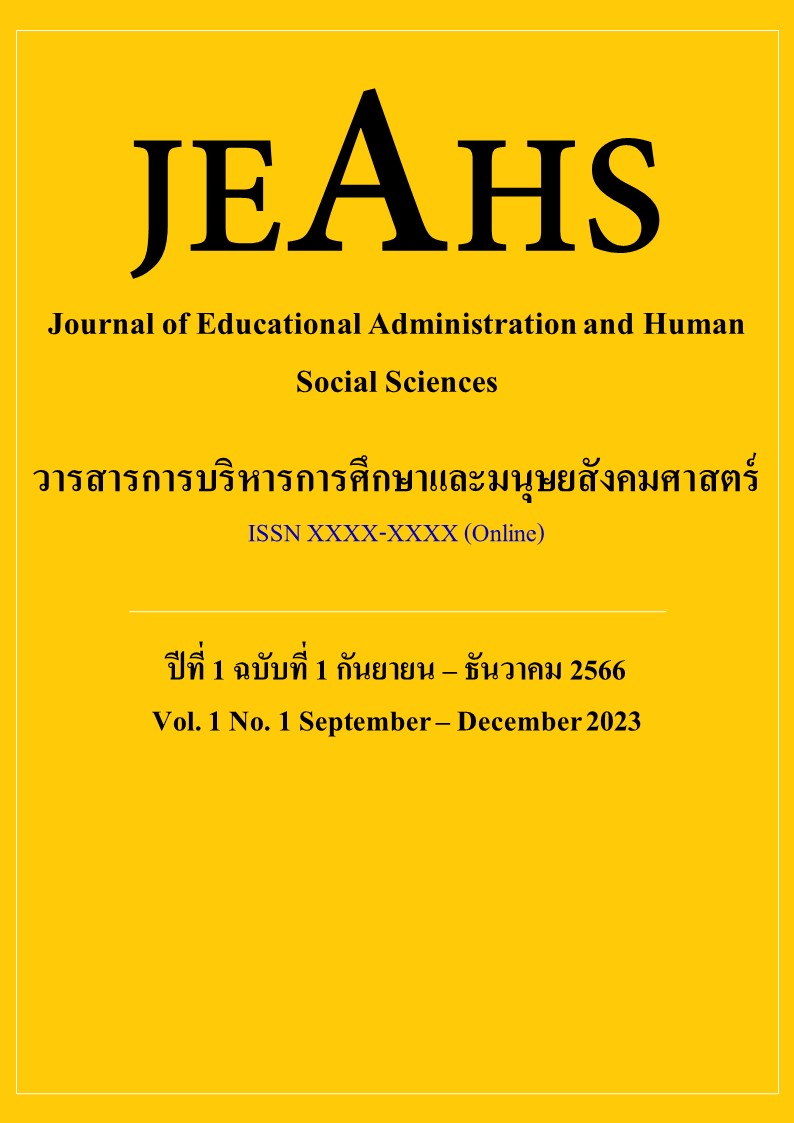DEVELOPMENT OF THE EDUCATIONAL MANAGEMENT MODEL OF PHRAPARIYATDHAMMA PALI SANAM LUANG ONLINE FOR PROMOTING THE EDUCATION OF MONKS AND NOVICES IN THE DIGITAL AGE
Main Article Content
Abstract
The purposes of this research article were 1) to study the educational management model of Phrapariyatdhamma Pali Sanam Luang for promoting the education of monks and novices, 2) to develop the educational management model of Phrapariyatdhamma Pali Sanam Luang online for promoting the education of monks in the digital age, and 3) to create a network for the educational management model of Phrapariyatdhamma Pali Sanam Luang online. Mixed methods research was designed with has 3 steps consisted of step 1 study the model, consisting of studying the concept and theory of organizing teaching and learning of the Pali Sanam Luang Pali section and using a questionnaire of 306 students from the Pali Department of Phrapariyatdhamma School; step 2 develop the model, consisting of interviews with key informants, and organizing focus group discussion with experts, conducted experiment, connoisseurship; and step 3 create a network consisted of improving and disseminating the online teaching of the Pali Sanam Luang section to a network of 5 schools. Results of the research found that 1) the educational management model of Phrapariyatdhamma Pali Sanam Luang for promoting the education of monks and novices consisted of 5 components which were teachers, curriculum, teaching and learning management, teaching media, measurement and evaluation, and has an opinions on the model in overall was at a high level. 2) The educational management model of Phrapariyatdhamma Pali Sanam Luang online for promoting the education of monks in the digital age has been developed. It consisted of principles, objectives and development processes which has 5 important aspects: 1) teachers who teach have knowledge and morality, create and integrate knowledge, have Kalyanamitra VII and teaching skills; 2) the curriculum has clear content, appropriate for the class level, students are proud to study, relying on memory and understanding; 3) teaching and learning, have skills in learning through online systems, coordinate the oral tradition (memorize) with appropriate techniques, organize learning through researching information; 4) teaching media, interesting modern media appropriate to the situation, a variety of teaching media using zoom, google meet, facebook programs; 5) measurement and evaluation, analyze results according to criteria, there were tools that help improve the quality of educational data collection. The measurement tools were valid, confidence and utilization. 3) Creating a network for the educational management model of Phrapariyatdhamma Pali Sanam Luang online for promoting the education of monks in the digital age was conducted in 5 schools, namely, Kalayanamit Woramahaviharn Temple School, Wat Phra Dhammakaya School, Wat Chak Daeng School, Sothon Wararam Worawihan Temple School, and Wat Molilokayaram School.
The results of the research found that 1) the format for organizing teaching and learning of the Pali Sanam Luang section to promote the education of monks and novices consists of 5 elements: teachers, curriculum, teaching and learning management. Teaching media and measurement and evaluation and has an effect on opinions on the format Overall, the opinions were at a high level. 2) The format for teaching the Pali Sanam Luang Pali section online to promote the education of monks and novices in the digital era has been developed. It consists of principles, objectives and development processes. Which has 5 important elements: 1) Teachers who teach have knowledge and morality, create and integrate knowledge. Have the 7 principles of good conduct and teaching skills. 2) The curriculum has clear content. appropriate for the class level Students are proud to study. Relying on memory and understanding 3) Teaching and learning Have skills in learning through online systems Coordinate the oral tradition (memorize) with appropriate techniques. Organize learning through researching information 4) Teaching media: interesting, modern media appropriate to the situation. A variety of teaching media, using zoom, google meet, feacbook programs. 5) Measurement and evaluation. Analyze results according to criteria There are tools that help improve the quality of educational data collection. The measurement tools are valid. confidence and use, and 3) creating a network for organizing online teaching of Pali Sanam Luang Pali teachings to promote the education of monks. Novices in the digital age, 5 schools, namely, Kalayanamit Woramahaviharn Temple School Wat Phra Dhammakaya School Wat Chak Daeng School Sothon Wararam Worawihan Temple School and Wat Molilokayaram School.
Article Details

This work is licensed under a Creative Commons Attribution-NonCommercial-NoDerivatives 4.0 International License.
บทความที่ส่งมาขอรับการตีพิมพ์ในวารสารวารสารการบริหารการศึกษาและมนุษยสังคมศาสตร์ จะต้องไม่เคยตีพิมพ์หรืออยู่ระหว่างการพิจารณาจากผู้ทรงคุณวุฒิเพื่อตีพิมพ์ในวารสารอื่น รวมทั้งผู้เขียนจะต้องคำนึงถึงจริยธรรมการวิจัย ไม่ละเมิดหรือคัดลอกผลงานของผู้อื่นมาเป็นของตนเอง ซึ่งทางวารสารได้กำหนดความซ้ำของผลงานด้วยโปรแกรม CopyCat เว็บ Thaijo ในระดับ ไม่เกิน 25%
ในกรณีที่ บทความวิจัยมีกระบวนการวิจัยเกี่ยวข้องกับมนุษย์ ผู้นิพนธ์จะต้องส่งหลักฐานการรับรองจริยธรรมการวิจัยในมนุษย์มาประกอบการลงตีพิมพ์ด้วยจึงจะได้รับการพิจารณาลงตีพิมพ์ในวารสาร
ผู้เขียนบทความจะต้องปฏิบัติตามหลักเกณฑ์การเสนอบทความเพื่อตีพิมพ์ในวารสารการบริหารการศึกษาและมนุษยสังคมศาสตร์ รวมทั้งระบบการอ้างอิงต้องเป็นไปตามหลักเกณฑ์ของวารสารการบริหารการศึกษาและมนุษยสังคมศาสตร์ โดยรวมทั้งทัศนะและความคิดเห็นที่ปรากฏในบทความในวารสารการบริหารการศึกษาและมนุษยสังคมศาสตร์ ถือเป็นความรับผิดชอบของผู้เขียนบทความนั้น และไม่ถือเป็นทัศนะและความรับผิดชอบของกองบรรณาธิการวารสารการบริหารการศึกษาและมนุษยสังคมศาสตร์ และวารสารการบริหารการศึกษาและมนุษยสังคมศาสตร์
References
กรมการศาสนา. (2542). การพัฒนารูปแบบการจัดการศึกษาพระปริยัติธรรมแผนกบาลี. รายงานการวิจัย. กรมการศาสนา.
กองบาลีสนามหลวง, (2553). สอบบาลีของสนามหลวงแผนกบาลี ปี 2553. กรุงเทพมหานคร: อาทรการพิมพ์.
กองบาลีสนามหลวง. (2557). บัญชีแสดงผลการสอบ ประโยคบาลีสนามหลวง พ.ศ. 2557 รวมทั้งส่วนกลางและส่วนภูมิภาค. กรุงเทพมหานคร: วัดปากน้ำ.
จิรภา อรรถพร และประกอบ กรณีกิจ. (2557). การพัฒนารูปแบบการสอนเชิงรุกออนไลน์เพื่อส่งเสริมพฤติกรรมการเรียนรู้ของนิสิตปริญญาบัณฑิต. วารสาร OJED. 9(4). 122-136.
บุญชม ศรีสะอาด. (2553). การวิจัยเบื้องต้น. พิมพ์ครั้งที่ 8. กรุงเทพมหานคร: สุวีริยาสาส์น.
พรชุลี อาชวอำรุงและคณะ. (2547). การจัดการศึกษาพระปริยัติธรรมแผนกธรรมและบาลี ของวัดสุทธิวารี จังหวัดนนทบุรี. รายงานวิจัย. สำนักนโยบายและแผนการศึกษา.
พระมหาบัณฑิต ปณฺฑิตเมธี. (2552). การบริหารสำนักเรียนพระปริยัติธรรมแผนกบาลี กรุงเทพมหานคร. วิทยานิพนธ์พุทธศาสตรมหาบัณฑิต. มหาวิทยาลัยมหาจุฬาลงกรณราชวิทยาลัย.
พระมหาแผน พูดพัด. (2543). ระบบการบริหารทางวิชาการที่มีประสิทธิผลของโรงเรียนพระปริยัติธรรม แผนกบาลี. วิทยานิพนธ์ศึกษาศาสตรมหาบัณฑิต. มหาวิทยาลัยศิลปากร.
พระมหาศักรินทร์ ศศพินทุรักษ์. (2515). หลักควรจำบาลีไวยากรณ์. กรุงเทพมหานคร: เลี่ยงเซียงจงเจริญ.
พระมหาสมหมาย ตเมโธ และคณะ, (2560). กลยุทธ์การสร้างแรงจูงใจในการศึกษาพระปริยัติธรรมแผนกบาลีของสำนักเรียนพระปริยัติธรรมแผนกบาลี. วารสารครุศาสตร์ปริทรรศน์ คณะครุศาสตร์ มหาวิทยาลัยมหาจุฬาลงกรณราชวิทยาลัย. 4(2). 56-67.
อนิรุทธ์ สติมั่น และฐาปนีย์ ธรรมเมธา. (2555). การพัฒนาชุดบทเรียนออนไลน์ เรื่อง วิธีการเรียนการสอนอีเลิร์นนิงสำหรับผู้สอนในสถาบันการศึกษา. วารสารศึกษาศาสตร์มหาวิทยาลัยศิลปากร. 10(1). 92-95.


